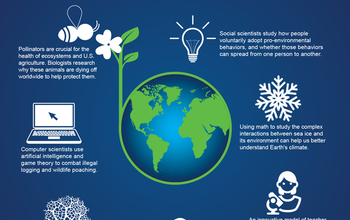
Research News
NSF-funded Nanosystems Engineering Research Center to enable deployment of mobile, efficient water treatment and desalination systems
March 31, 2016
Water, water is everywhere, but we need more drops to drink.
The primary mission of the recently founded Nanotechnology Enabled Water Treatment (NEWT) Center, a consortium based at Rice University and led by environmental engineer Pedro Alvarez, is to produce more drinkable drops where they’re needed the most.
According to Alvarez, treated water is too often unavailable in parts of the world that cannot afford large treatment plants or miles of pipes to deliver it. Moreover, large-scale treatment and distribution uses a great deal of energy. “About 25 percent of the energy bill for a typical city is associated with the cost of moving water,” he said.
The center, funded by a five-year, $18.5 million National Science Foundation (NSF) award was founded to transform the economics of water treatment by using nanotechnology to develop compact, mobile, off-grid systems to provide clean water to millions of people around the world. A second goal is to make U.S. energy production more sustainable and cost-effective in regards to its water use.
NEWT is the first NSF Engineering Research Center (ERC) based in Houston. ERCs are interdisciplinary, multi-institutional centers that join academia, industry and government in partnership to produce both transformational technology and innovative-minded engineering graduates primed to lead the global economy. ERCs often become self-sustaining and typically leverage more than $40 million in federal and industry research funding during their first decade.
Water has long been a passion for Alvarez, who studies treatment and re-use, remediation strategies for contaminated aquifers and the water footprints of biofuels. His work also covers the environmental implications of using nanotechnology, and the transport — and eventual fate of — toxic chemicals in the environment. As NEWT director, he partners with researchers at Arizona State University (ASU), Yale University and the University of Texas at El Paso.
The consortium set as its first goal the development of modular water treatment systems that can deploy almost anywhere in the world. But Alvarez said the potential to make a significant impact is already expanding, with opportunities to address wastewater treatment at oil and gas drilling sites, nano-infused desalination in urban environments and improved water treatment through more efficient filtration at existing plants.
Alvarez paused between classes recently to talk about the center’s plans.
Q. Where do you think NEWT’s greatest impact will be in 10 years?
A. It will be in drinking water, providing cleaner water to millions of people who now lack it. I think it’s going to be in developing small, portable units that will not only provide humanitarian water but also emergency response.
There will be other Flints. There will be other Elk River spills that will impact municipalities and water. I think we will be able to respond to those things.
We will probably have tremendous impact on desalination. Low-energy desalination will be one of our hallmarks, I believe. Of course, we will be very good also at treating some of the oil-and-gas water issues, but that’s a more difficult problem.
I expect we’ll also have high institutional impact because people may be more ready to consider unconventional water sources using portable systems that are easier to deploy. People are going to start considering more and more decentralized water-treatment approaches, especially as new cities and neighborhoods and developments evolve.
Q. What kind of sources will your technology be able to treat?
A. Briny ground water, for example, could be a source of drinking water in areas experiencing drought. Or in coastal areas. I think we will see more of that. We’ll see more harvesting of storm water, certainly, and for some uses, even greywater.
Those are the kinds of things our technologies will enable, but it’s not just about technology. It’s about the philosophy of changing to more sustainable, integratable water management, where we re-use more water, where we tap water that we thought was of too low quality but, as it turns out, is perfectly fine and safe and more economical for a sole intended use.
Q. In what directions are the initial projects headed?
A. I think the first thing we’re going to have out there is an adsorbent filter being developed by [NEWT deputy director] Paul Westerhoff at ASU. It’s a block of carbon with embedded nanoparticles. These particles adsorb — that is, they grab onto and hold — oxyanion contaminants like nitrate, arsenic and chromate, and effectively remove them from the water supply. [Oxyanions are negatively charged ions that contain oxygen.] It will be part of a drinking-water treatment unit.
Q. Would the technology apply to large water treatment plants?
A. Yes. Though we originally intended to carve a niche in the decentralized water treatment market, we do aspire to bigger things as our products, materials and processes gain momentum.
I am sure there will be a lot that can be used by the municipal water treatment community. It’s a more difficult industry to penetrate because it’s very conservative. You have to convince them that a technology is going to save them a lot of money and that they don’t have to change too much of the infrastructure or the configuration of the plant.
We have some very good ideas of things that will fit them. If they’re already using membranes for filtration, for example, our membranes may offer better rejection of contaminants and perhaps less susceptibility to being fouled, so they will last longer without having to be replaced. They won’t clog up as easily. They will not use as much energy.
Q. Why did you pursue hosting this NSF center?
A. I think that we as scientists and as engineers, especially in developed countries, have a social debt toward many poor people who lack access to clean water because they are denied the right to a life consistent with their inalienable dignity.
The lack of clean water is a major hindrance to human capacity. It goes beyond public health: It’s directly tied to the need for economic development.
That is certainly one important factor in my passion to provide water to many. It’s related to the concept of world affirmation, the idea that the world can be a better place and we can do something about it. Providing clean water is one way to do it.
The other big incentive was to try to move towards energy self-sufficiency in the United States in a manner that is more cost-effective and more sustainable with regards to the water footprint.
A major challenge for our energy industry is that they need to operate and extract oil and gas in areas that are relatively dry and semi-arid, where water is scarce. And they need relatively large quantities of water to obtain this energy. To get a barrel of oil in Texas, you need about 10 barrels of water. To frack a well to get shale gas or shale oil, you may need up to 6 million gallons of water, again in areas where water is scarce.
Once it’s used, disposal of that water becomes a major challenge and a potentially serious source of pollution. So the solution to both scarcity and minimizing impact is to re-use this water. That’s one of the things we’re trying to do: develop systems that are small and easily deployed that can enable industrial wastewater re-use in remote areas.
Q. What can you do with nanoparticles that you couldn’t have done before?
A. We need to recognize that at the nanoscale, the properties of matter change. Some elements, such as gold, that are very inert can become hypercatalytic at that scale, and materials that are good insulators like carbon can become superconductors.
When you exploit these extraordinary size-dependent properties, it allows you to introduce multifunctionality at both the reactor and materials level. This combination of multifunctionality — for example, membranes that have self-cleaning and self-healing properties — with the nanotechnology-enabled ability to selectively remove pollutants allows you to have smaller reactors. These can treat even unconventional sources of water, difficult sources, that currently would require huge reactors and very large and complex treatment trains that are impossible to take to remote locations.
Making them smaller, multifunctional and modular brings you tremendous versatility to handle a wide variety of challenges in water purification. Nanotechnology allows us to do that. It’s essential to our vision of decentralized water treatment systems.
Q. You’re an environmental engineer who knows aquatic chemistry, and you rely on other kinds of engineers and scientists for different parts of the water systems.
A. Absolutely. This has to be a multidisciplinary collaborative effort to build this innovation ecosystem. We need people who know how to make materials and people who know how to characterize them, how to immobilize them, how to manipulate them — how to assess their reactivity and bioavailability and mobility, and eventually scale them up.
We want people who are good at designing and building reactors all the way to systems to think about the whole life cycle, the technoeconomic implications of these materials, to make sure they’re feasible and improve on current practices.
They have to do it in a way that’s sustainable and avoids unintended, undesirable consequences as well.
Alvarez is the George R. Brown Professor of Environmental Engineering in the Department of Civil and Environmental Engineering at Rice University.
[This interview has been condensed.]
—
Mike Williams,
Rice University
(713) 348-6728 mikewilliams@rice.edu
-
Pedro Alvarez leads the design of smaller, multifunctional and modular water treatment systems.
Credit and Larger Version -
NEWT Center uses nanotechnology to transform the economics of water treatment.
Credit and Larger Version
Investigators
Pedro Alvarez
Menachem Elimelech
Naomi Halas
Qilin Li
Paul Westerhoff
Related Institutions/Organizations
William Marsh Rice University
Arizona State University
University of Texas-El Paso
Yale University
Locations
Arizona
Connecticut
Texas
Related Programs
Engineering Research Centers
Related Awards
#1449500 NSF Nanosystems Engineering Research Center for Nantechnology Enabled Water Treatment Systems (NEWT)
Total Grants
$3,250,000
Related Websites
NSF Special Report: Cleaner Water, Clearer Future: https://www.nsf.gov/water
Source: NSF News
Brought to you by China News









